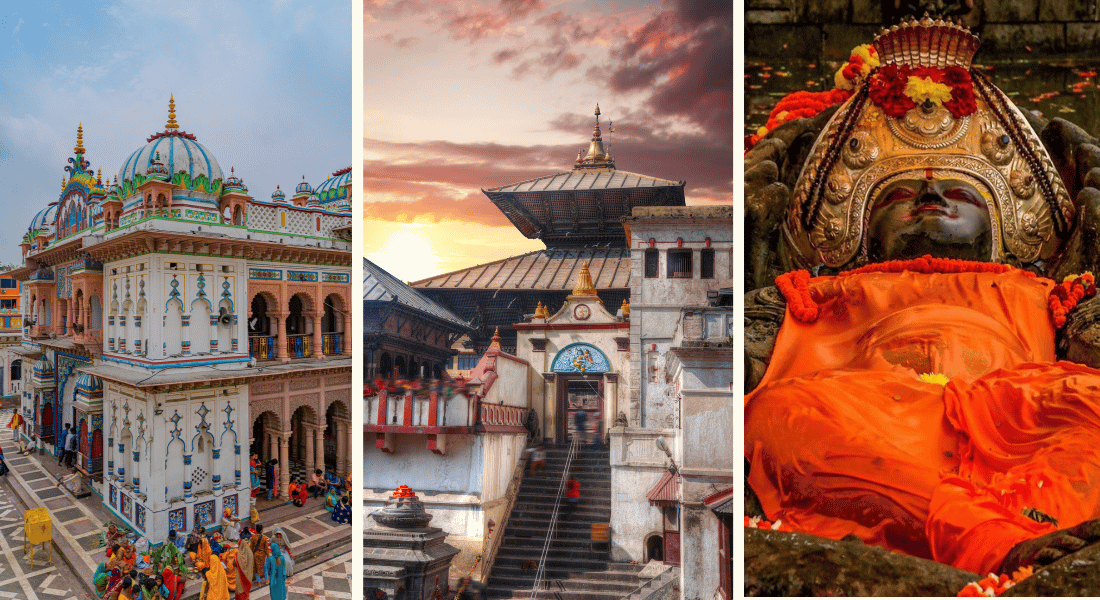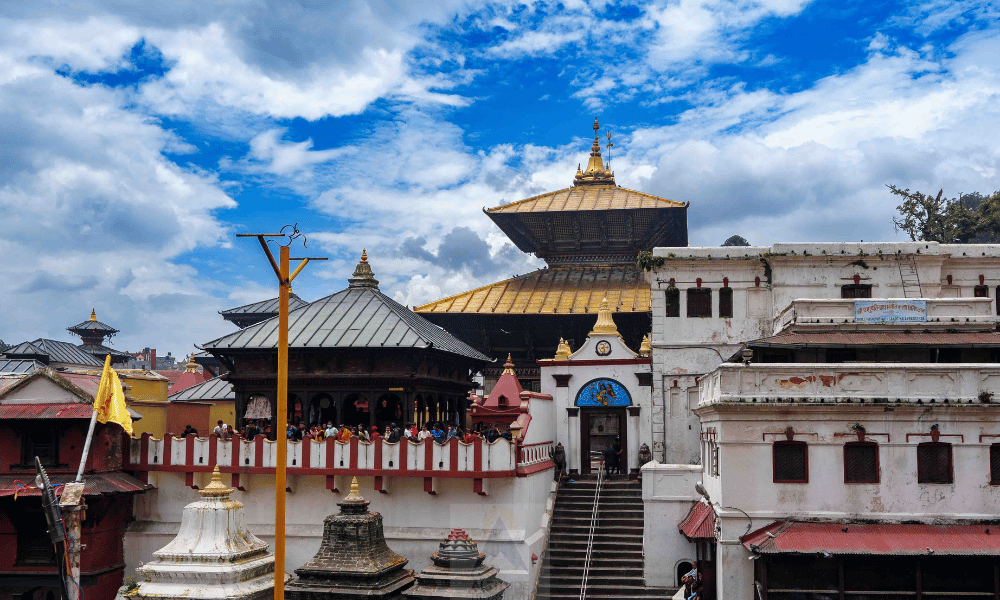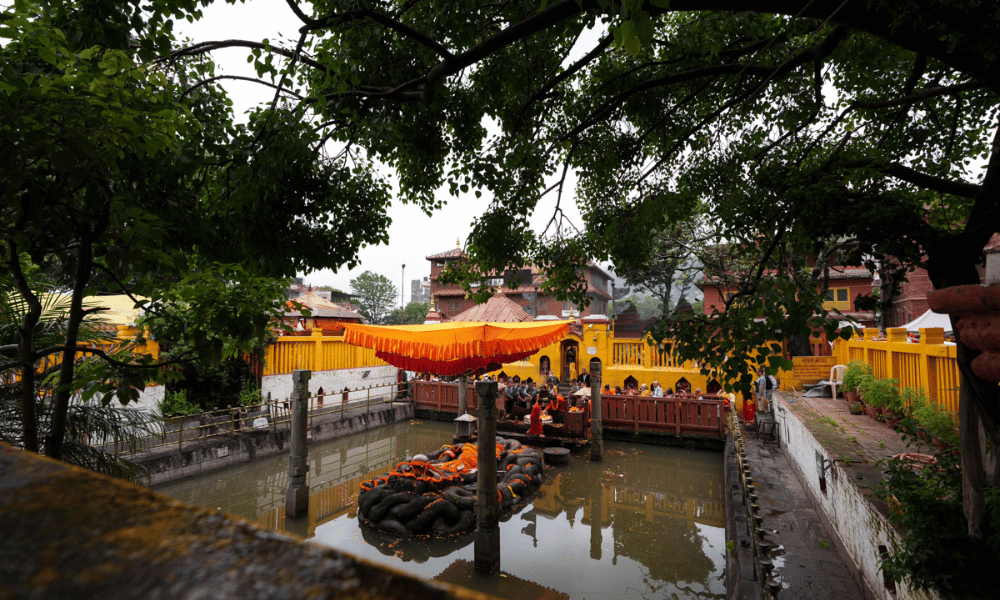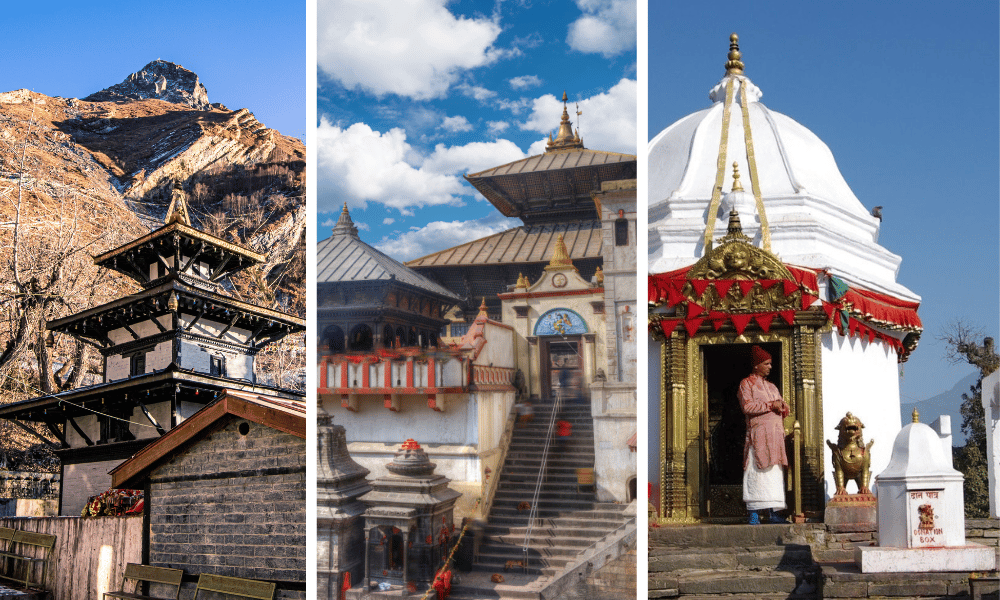Nepal, a beautiful country situated in the lap of the Himalayas, is not only famous for its stunning mountains and other natural attractions but also for its spiritual presence. Nepal is home to a significant number of Hindu temples, some estimating over 4000, including well known and small temples. These temples are spread all over the country from the east to the west and from Terai to the Himalayas. Due to the majority of Hindu population, the country has an abundance of Hindu temples more than other monuments of other religions. Not just Hindus, but because of the religious cohabitation of two of the world's oldest religions, Hinduism and Buddhism, several temples, such as Muktinath, Halesi Mahadev, Guhyeshwori, and others, are adored by both.
Kathmandu, the capital city of Nepal, is also well known as the city of temples, which shows how spiritual the country is. Hindu pilgrimage sites in Nepal are not just a famous tourist destination but also a highly spiritual place for Hindu devotees and pilgrims from all over the world, making them a must-see attraction for those planning a pilgrimage vacation to Nepal. Some of the major Hindu temples, like the Pashupatinath Temple and Muktinath Temple, have been pilgrimage destinations for over centuries. Most of these monuments are within the Kathmandu valley, among which some of them are listed as world heritage sites by UNESCO. Thus, Nepal is one of the popular pilgrimage destinations among the Hindu people across the world.
In this blog, we have compiled some of the major Hindu pilgrimage sites in Nepal with a brief introduction of the sites with facts about them and also a quick guide to reach to these holy destinations. We are aiming to guide you through these spiritual destinations, making your pilgrimage a success and a fruitful journey. Join us on this journey by exploring these sacred temple doors and admiring their spiritual aura along with their architectural beauty.
Table Of Content
- Hinduism in Nepal
- List of Major Hindu Pilgrimage Sites in Nepal
- Pashupatinath Temple
- Guhyeshwari Temple
- Jal Narayan Temple
- Shesh Narayan Temple
- Dakshinkali Temple
- Changu Narayan Temple
- Doleshwor Mahadev Temple
- Patan Area
- Manakamana Temple
- Bindyabasini Temple
- Halesi Mahadev Temple
- Pathibhara Devi Temple
- Janakpurdham
- Muktinath Temple
- Devghat
- Travel Tips for Pilgrims
- Conclusion
- Frequently Asked Questions (FAQs)
Hinduism in Nepal
Hinduism, the oldest religion in the world and also the world's fourth-largest religion, has been the main religion in Nepal for a long time. According to the 2021 census conducted by the National Statistics Office, the total population of people following Hindu religion in Nepal amounts to 2,36,77,744 people, which is about 81.19% of the whole population of the country. It is the highest percentage of Hindus in any country in the world. The people following Hinduism are spread across the whole country, creating a spiritual environment wherever one goes. That is why a lot of significant Hindu pilgrimage sites have been spread around the country.

Before the 2006 democratic movement to overthrow the monarchial system, Nepal was officially a Hindu nation. Even the kings of the country were considered an incarnation of Lord Vishnu, one of the three primordial gods in Hinduism. After that, Nepal was declared a secular country. Even after being a secular state, Hinduism is so intertwined in the daily life in Nepal that many do not notice it immediately. From the smell of the burning incense in the morning to the calendar system Nepalese people follow, all are somehow connected with Hinduism.
Hinduism in Nepal is not only seen through the beautiful temples but also marked by the colourful festivals and rituals, which are celebrated by all with deep religious feelings. Festivals like Dashain and Tihar are celebrated with great enthusiasm by the whole country. These lively Hindu festivals bring alive the temple’s charm and attract a huge number of devotees, especially during the Shivaratri, when thousands of pilgrims visit the almighty Pashupatinath seeking blessings from Lord Shiva himself. For someone seeking a religious Hindu pilgrimage, Nepal is probably the best choice.
List of Major Hindu Pilgrimage Sites in Nepal
Here is a list of some of the major Hindu pilgrimage sites in Nepal:
|
Temples |
Location |
|
Pashupatinath Temple |
Gaushala, Kathmandu |
|
Guhyeshwori Temple |
Gaushala, Kathmandu |
|
Jal Narayan Temple |
Budhanilkantha, Kathmandu |
|
Shesh Narayan Temple |
Dakshinkali, Kathmandu |
|
Dakshinkali Temple |
Pharping, Kathmandu |
|
Changunarayan Temple |
Bhaktapur |
|
Doleshwor Mahadev Temple |
Suryabinayak, Bhaktapur |
|
Patan Area |
Lalitpur |
|
Manakamana Temple |
Kurintar, Gorkha |
|
Halesi Mahadev Temple |
Halesi, Khotang |
|
Pathibhara Devi Temple |
Pathivara, Taplejung |
|
Janakpurdham |
Janakpur |
|
Muktinath Temple |
Mustang |
|
Devghat |
Chitwan |
Pashupatinath Temple
The Pashupatinath Temple is one of the most revered Shiva temples in the world. If you are a devotee of Lord Shiva, you must visit Pashupatinath. This sacred temple is located in the centre of Kathmandu on the banks of the Bagmati River and covers an area of around 246 hectares (2.56 km square), which includes multiple temples dedicated to various gods and goddesses, several ashrams, a cremation place, mirgasthal (deer sanctuary), open spaces, and more. Because of its high significance, the Pashupatinath Temple was declared a World Heritage Site in the year 1979.
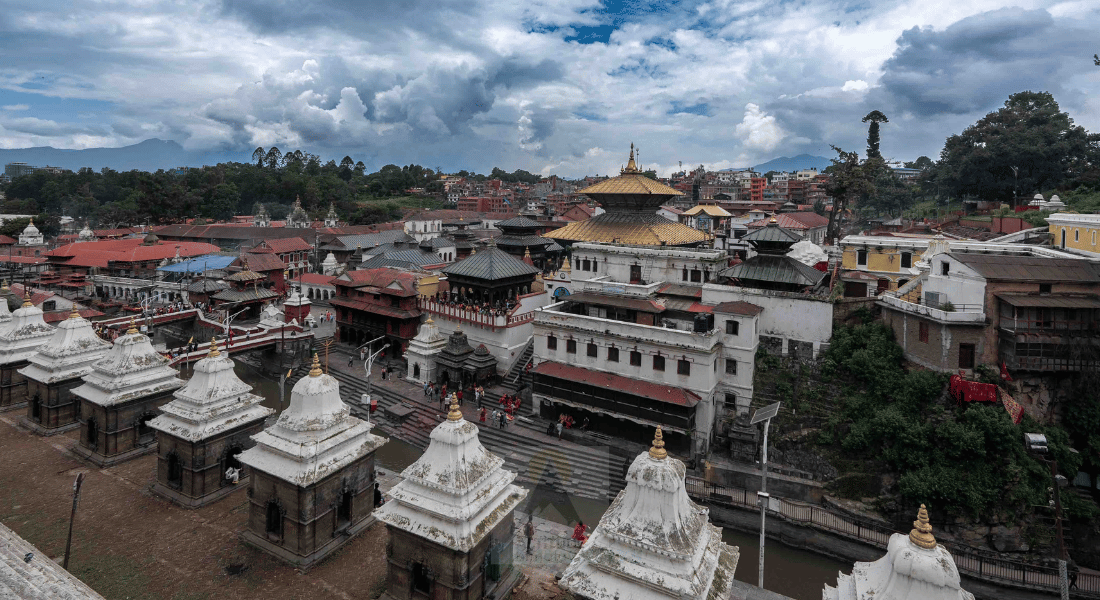
The Pashupatinath temple is a stunning two-story structure in the pagoda style, with copper roofs covered in gold and a gold pinnacle. The temple features four major doorways, one for each cardinal direction. Visitors can deliver their offerings via all four doors, which open at 4 a.m. and close during bhog time. The temple has two sanctums: the outer sanctum, where the helpers (Rajbhandari’s) take offerings from the devotees, and the inner sanctum, where the main priest (Bhatta’s) receives devotees offerings through the helpers and presents them to the almighty Pashupatinath in the form of a four-faced Shiva linga. One unique aspect of Pashupatinath Temple is that the principal priests are from India, not Nepal.
Every year, millions of devotees and visitors alike visit the ancient temple, either to admire its beauty or to seek blessings from the all-powerful Pashupatinath. The temple is visited by hundreds of people every day, but during major festivals such as Shivaratri, Teej, and the final Monday of Shrawan month, Pashupatinath experiences a surge of devotees, creating a very spiritual environment within the temple premises. The temple receives a large number of foreign pilgrims, particularly during Shivaratri. Devotees dance and sing bhajans, creating a lively atmosphere at the temple.
Pashupatinath Temple Facts
Here are some facts related to Pashupatinath Temple:
|
Site |
Pashupatinath Temple |
|
Affiliation |
Hinduism |
|
Deity |
Lord Shiva |
|
Location |
Gaushala, Kathmandu |
|
Major Attractions |
|
|
Major Festivals |
|
|
Architecture Style |
Pagoda Style |
|
Opening Hours |
04:00 AM – 12:00 PM 05:00 PM–09:00 PM |
|
Entry Fee |
NRs. 1000 for Foreigners (Free for Nepalese and Indians) |
How to reach?
Reaching Pashupatinath is actually quite easy. First and foremost, one needs to come to Kathmandu to visit this temple, wherever you are from. The temple is just 3.1 km from the Kathmandu city centre and just 2.8 km from Tribhubhan International Airport. From there, you can either book a private vehicle or hire a taxi to reach Pashupatinath Temple. If one is seeking to travel by public bus, which is a cheaper option, there are many places in Kathmandu from where one can find a public bus going to Gaushala. If one doesn’t find it, then you can take a bus to Jamal and then take a bus to Gaushala. After getting off at Gaushala, now you can see the Pashupatinath area, which you will have to explore on foot.
Learn More: Pashupatinath Temple
Guhyeshwari Temple
Guhyeshwari Temple is one of the 51 Shakti Peetha scattered around south west Asia. Shakti Peetha are the sacred sites where body parts of goddess Sati fell when Lord Shiva, in remorse of Sati’s death, carried her body around the universe. It is believed that this specific Shakti Peeth is where both knees or the hind part of Goddess Sati fell. The appeal of this temple is further enhanced by its closeness to the almighty Pashupatinath Temple. This temple is highly regarded in the world of tantric practice, attracting tantric practitioners from all over the world.
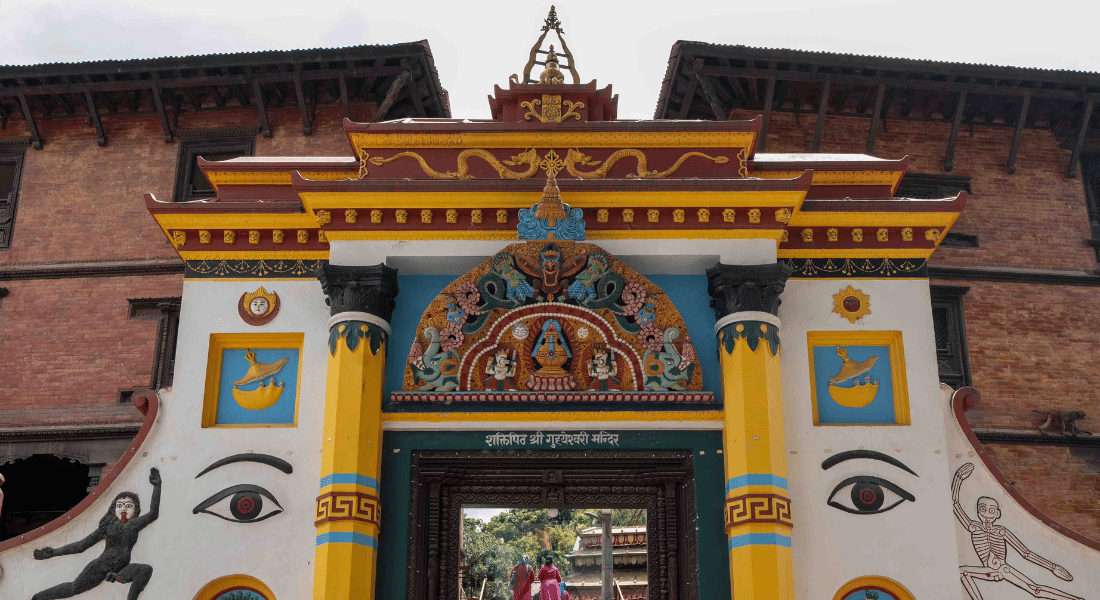
The word Guhyeshwari is composed of two Sanskrit words: "Guhya”, which means hidden, and "Ishwari”, which means goddess, making it the temple of the hidden goddess. The temple has beautiful architecture with no specific style. The temple structure is decorated with beautiful icons and designs covered with gold and silver all around the temple architecture. The temple structure is surrounded by lion figures as a symbol of the goddess's sacred ride/mount. The roof is surmounted by four golden snakes that protect the final roof. The goddess is revered at the centre of the sacrosanctum in the form of kalash, covered in layers of silver and gold, which is placed on top of a golden lotus. The scaro sanctum also bhairav (Shiva’s Form) and also other deities.
Tantric practitioners worship at this temple, and the priest conducts Tantric rites on a regular basis as Nitya Karma. This temple is regarded as one of the best venues to gain tantric control. During the first ten days of Dashain (Navaratri), the Hindus' most important festival, devotees travel from all around to worship Goddess Guhyeshwari.
Guhyeshwari Temple Facts
Here are some facts related to Guhyeshwari Temple:
|
Site |
Guhyeshwari Temple |
|
Location |
Gaushala, Kathmandu |
|
Affiliation |
Hinduism |
|
Deity |
Guheykali (Sati) |
|
Architecture Style |
Pagoda |
|
Major Attraction |
Temple’s Architecture |
|
Major Festivals |
|
|
Opening Hours |
04:00 AM – 07:30 PM |
|
Entry Fee |
No Entry Fee |
How to reach?
The temple is located about 3.9 kilometres from Kathmandu's city centre and 1 kilometre from the famous Pashupatinath temple. To get to the temple, simply book a cab or use a ride-sharing app from your location for ease. Another option is to take a public bus to Gaushala and first visit the Pashupatinath Temple, then find a way to Guhyeshwari across the Bagmati River and make your way to the temple, passing through Gorakhnath Temple, Mirgasthal, and finally arriving at Guhyeshwari.
Jal Narayan Temple
Jal Narayan Temple, located at the foot of the Shivapuri Hills, is one of the four Narayan temples in Kathmandu Valley. It is also known as the Budhanilkantha Temple. It is an open-air temple with the huge, single stone-carved sleeping Vishnu as the focal point of worship. The temple is revered by both Hindus and Buddhists. The Hindus consider the deity of the temple as Lord Vishnu, while the Buddhists consider him a manifestation of Avalokiteshvara. The temple's name, "Jal Narayan," refers to the Narayan in water, while another name, “Budhanilkantha”, is a combination of two words, "Budha," meaning "old," and "Nilkantha," meaning "blue throat."

The temple is also known as the temple of sleeping Vishnu. The reclining statue is 5 metres tall, depicting Lord Vishnu with 4 hands each holding a sacred item and sleeping in the coil of serpents surrounded by a pool of water. The statue is decorated with ornaments like the crown and balis (bangles). One unique thing about this temple’s rituals is that the priests who take care of the temple and conduct the daily rituals of the temple are children. For the priest to worship the idol, they have to step on Sesh Nag, which is a sin. To avoid the sin, the worshipping rituals are performed by Bhramins of less than 16 years because young brahmins are excluded from the sin that comes with stepping on the Sesh Nag.
This temple is a famous pilgrimage site dedicated to Lord Vishnu and is a centre of attraction for Hindu devotees. Every year during Haribodhini Ekadashi (Thuli Ekadashi), when Lord Vishnu is said to wake up from his slumber from the Harisayani Ekadashi. Many Hindu pilgrims from within the country or from outside the country visit this scared temple with a sense of reverence in their hearts.
Jal Narayan Temple Facts
Here are some facts related to Jal Narayan Temple:
|
Site |
Jal Narayan Temple (Budhanilkantha Temple) |
|
Location |
Budhanilkantha, Kathmandu |
|
Affiliation |
|
|
Deity |
|
|
Architecture Style |
Open Air |
|
Major Attraction |
|
|
Major Festivals |
|
|
Opening Hours |
04:00 AM – 07:30 PM |
|
Entry Fee |
No Entry Fee |
How to reach?
The temple is situated approximately 8 kilometres north of Kathmandu's city center. To reach the Jal Narayan Temple, one needs to come to Kathmandu first and foremost. You can hire a taxi or take a local bus from various points in Kathmandu, such as Ratna Park or Jamal. Simply tell the driver or conductor that you want to go to "Budhanilkantha," and they will drop you off near the temple.
Learn More: Budhanilkantha Temple
Shesh Narayan Temple
Shesh Narayan temple, also known as Shikhar Narayan, is also one of the 4 narayans of Kathmandu Valley, and it is the narayan of the south cardinal direction. Located 21 km south-west of Kathmandu in the picturesque town of Pharping, this temple is dedicated to Lord Vishnu but is also revered by Buddhists too due to its connection with Padmasamva. This temple is believed to have been constructed during the reign of Hari Dutta Verma, who is said to be responsible for the construction of the other 3 Narayan temples in Kathmandu Valley as well. It is a newari pagoda style temple with a roof made up of copper supported by wooden beams adorned with artistic carvings.

There are 5 kunda/ponds in the surroundings of Shesh Narayan Temple, namely Bansuri kunda, Surya kunda, Gosai kunda, Bhairav kunda, and Saraswoti kunda, each having their own distinct significance. It was said that these ponds used to be one huge pond from where the water was used to wash the idol of Lord Vishnu. One can also see various kinds of fish in these ponds. The temple is situated right under a rocky cliff. There is also a cow’s brest shaped rock above the main temple believed to be of Kamdhenu cow. Inside the temple there are idols of different forms of Narayan, namely Narsimha Narayan, Shesh Narayan, and Gadhadhar Narayan, along with idols of other gods and goddesses. On the right of the temple is Chamunda Sakti Peeth, and to the left are numbers of idols of Lord Vishnu as well as of Lord Buddha. There is a cave adjacent to the cave, which is called the Gorakhnath Cave, through which it is believed to reach the Gorkahnath temple. Whereas Buddhists believe that Padmasambhava meditated in this cave and call it the Padmasambhava Cave. There is also a monastery in the temple area, showcasing the religious harmony between Hinduism and Buddhism. There are also several other attractions besides the main temple, like the Rakdha Krishna Mandir, the Garud Narayan Mandir, and others.
This temple attracts devotees and pilgrims through the year and has been a centre of reverence for years. During all Ekasdashi, this temple is filled with local devotees seeking blessings from Lord Vishnu. Especially the temple comes into it’s full glory during the Haribodhini Ekadashi, when Lord Vishnu is said to wake up from his slumber. During this time, not only the local devotees visit the temple but also the nathyogis. Similarly, during the Hari Shankhar Yatra, both Lord Vishnu and Lord Shiva are praised, and processions with their idols are taken out. This temple also hosts the Nitya Puja (Daily Rituals) conducted by the Rajopadhyaya Preists.
Shesh Narayan Temple Facts
Here are some facts related to Shesh Narayan Temple:
|
Site |
Shesh Narayan Temple/Shikhar Narayan Temple |
|
Location |
Pharping, Dakshinkali, Kathmandu |
|
Affiliation |
|
|
Deity |
|
|
Architecture Style |
Newari Pagoda |
|
Major Attraction |
|
|
Major Festivals |
|
|
Opening Hours |
4:00 AM – 7:30 PM |
|
Entry Fee |
No Entry Fee |
How To Reach?
The temple is about 20 kilometres south of the city and accessible by both private and public transportation. If you're using public transport, you can take a bus or microbus from Ratna Park or Balkhu towards Pharping and get off at the Pharping bus stop. From there, it's a short walk to the temple. The temple is situated in a serene environment surrounded by hills, making the journey scenic.
Dakshinkali Temple
Dakshinkali is widely regarded as one of Nepal's most powerful temples, devoted to the fearsome Kali mata. The name "Dakshinkali" is made up of two words: "Dakshin," which means south, and "Kali," the goddess, which, when combined, means "The Kali of the South". This temple is highly valued by locals, and many devotees visit it on a regular basis. Dakshinkali Mata is seen as a compassionate mother who shields her devotees and children from harm and misfortunes. The temple is highly revered by those seeking blessings for protection and fulfilment of wishes.
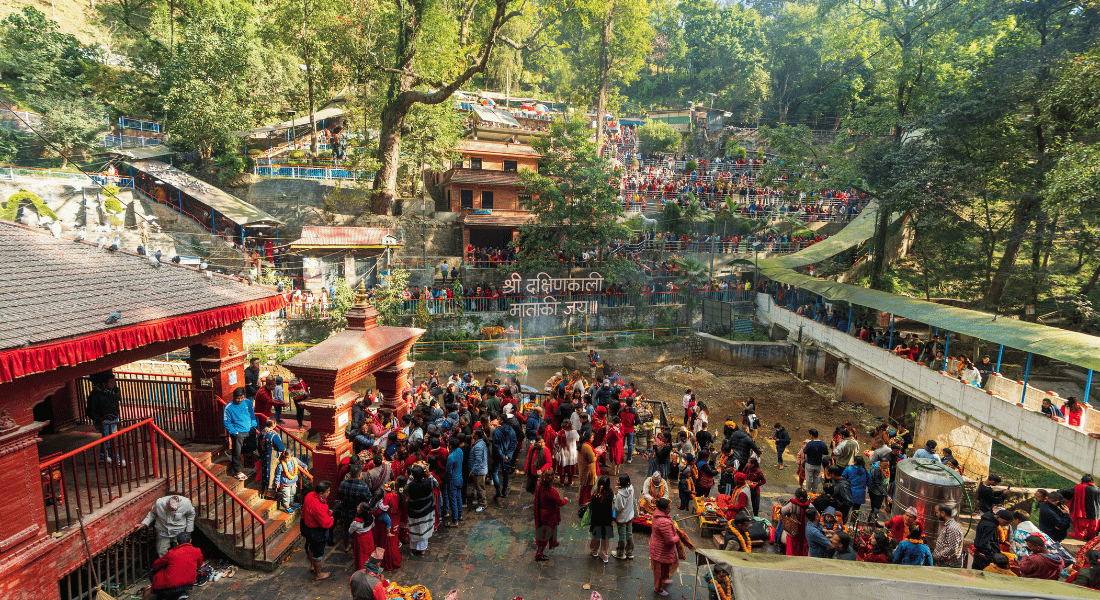
Situated roughly 22 kilometres away from the heart of Kathmandu, this temple has long been a popular pilgrimage site for both locals and visitors. In the past, even kings held important rituals there. It is an open-air temple with the primary goddes Kali in the middle, surrounded by other deity statues. Kali Mata's idol is formed of a single chunk of black stone and is two feet tall. The Dakshinkali deity has four hands, each with a holy object. The idol is typically dressed with jewels, such as a silver crown and several necklaces.
The Dakshinkali temple has been a pilgrimage site for many over a long period of time. The temple is visited by many devotees on a daily basis, but particularly during festivals like Dashain, people from all across Nepal pay a visit to the Dakshinkali Temple to seek her blessings and offer their sacrifices. It is customary to sacrifice animals, usually male goats and hens, in remembrance of the fierce goddess Kali. Similarly, during Kalika Jayanti, Shivaratri, and occasions like New Year, people visit this temple to get blessings from Kali Mata.
Dakshinkali Temple Facts
Here are some facts related to Dakshinkali Temple:
|
Site |
Dakshinkali Temple |
|
Location |
Pharping, Kathmandu |
|
Affiliation |
Hinduism |
|
Deity |
Goddess Kali |
|
Architecture Style |
Open |
|
Major Attraction |
|
|
Major Festivals |
|
|
Opening Hours |
05:00 AM – 11:00 PM 01:00 AM – 08:00 PM |
|
Entry Fee |
No Entry Fee |
How to Reach?
To reach Dakshinkali Temple, located about 22 kilometres from Kathmandu, Nepal, you can take a bus or taxi from the city. Public buses to the temple typically depart from the Ratnapark Bus Station or from near the Old Bus Park in Kathmandu, heading towards Pharping, which is en route to the temple. The journey takes around 1 to 1.5 hours, depending on traffic and road conditions. Alternatively, hiring a private vehicle or taxi is faster and more convenient, especially if you prefer a more comfortable ride. The scenic drive takes you through hills, forests, and rural villages, offering a peaceful escape from the bustling city.
Learn More: Dakshinkali Temple
Changu Narayan Temple
Changu Narayan temple, which is dedicated to Lord Vishnu, is recognised as the oldest temple of Nepal. It is an UNESCO World Heritage Site located atop a small hill in the district of Bhaktapur. Also known as Champak Naraya, the temple is surrounded by Champak forest. Changu Narayan Temple, being one of the four narayan temples of the Kathmandu Valley, is the narayan of the west. The temple is one of the most beautiful temples in Nepal, said to have been constructed during the Lichhavi Period.
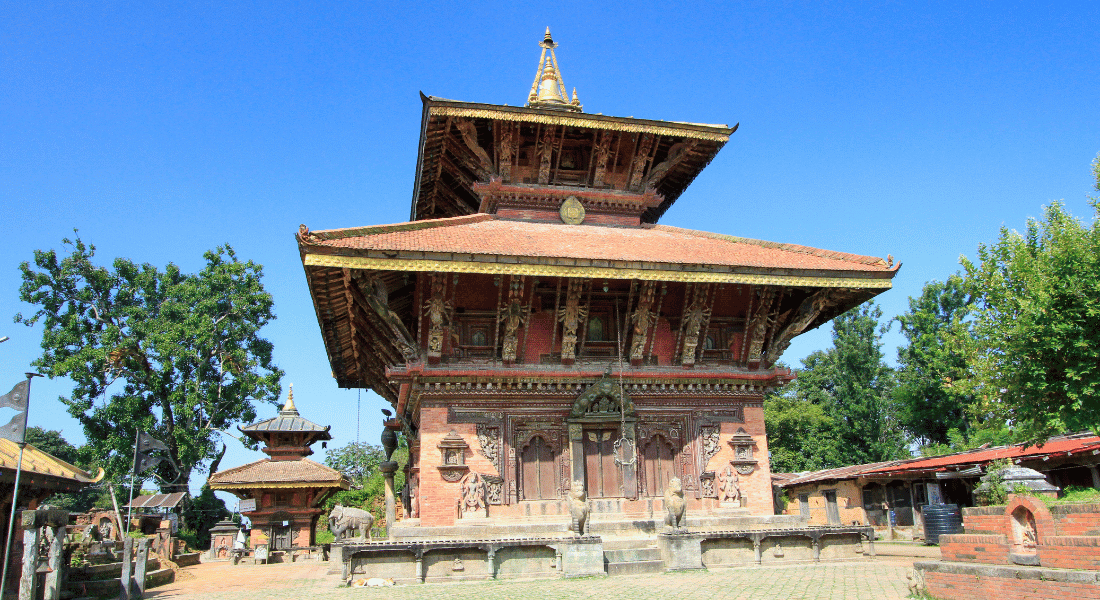
It is a two story temple pagoda style architecture with various carvings on the studs holding the roof of the temple. On these studs there are different forms of Lord Vishnu known as the Dashavatara. They are the ten major avatars of Lord Vishnu, who were incarnated to bring peace to the world by defeating the evils. Several other significant temples surround this temple, like the Chinnamasta temple dedicated to Goddess Durga and the Kileshwor Mahadev temple dedicated to Lord Shiva. An idol of Vishnu’s sacred ride, a statue of King Bhupatindra Malla with Queen Bhuwan Laxmi, and stone monoliths with Sankha and Chakra on top in front of the temple’s main entrance.
One of the best known Vishnu temples in Nepal and is visited by a large number of devotees, particularly during festivals like Harishatani and Haribodhini Ekadashi. One of the major festivals that is celebrated in the temple is the Kalash Yatra, during which a procession of three silver urns representing Lord Vishnu, Goddess Lakshmi, and Goddess Saraswati is carried by three priests of the Changunarayan Temple filled with water from the Bagmati river. The procession is done from the Changu Narayan Temple to the Hanuman Dhoka, following the route Mulpani – Bouddha – Kalopul – Dillibazar – Ranipokhari – Makkhan tole to Hanuman Dhoka, all barefoot.
Changunarayan Temple Facts
Here are some facts related to Changunarayan Temple:
|
Site |
Changu Narayan Temple |
|
Location |
Changu Narayan, Bhaktapur |
|
Affiliation |
Hinduism |
|
Deity |
Lord Vishnu |
|
Architecture Style |
Newari Pagoda |
|
Major Attraction |
|
|
Major Festivals |
|
|
Opening Hours |
04:00 AM – 10:00 PM |
|
Entry Fee |
|
How to Reach?
Changu Narayan Temple, located near Bhaktapur in the Kathmandu Valley of Nepal, is accessible by various modes of transportation. From Kathmandu, you can take a public bus or microbus from Ratna Park or Bhaktapur to reach the town of Changu. The journey takes about an hour, covering a distance of around 20 kilometers. Alternatively, you can hire a taxi or private vehicle for a more convenient and quicker trip. Once in Changu, a short hike of about 15-20 minutes leads you uphill to the ancient temple, offering scenic views of the valley along the way. The temple is also accessible from Nagarkot through a scenic hiking trail for those interested in trekking.
Learn More: Changunarayan Temple
Doleshwor Mahadev Temple
Doleshwor Mahadev Temple is one of the most important temples dedicated to Lord Shiva, located in Suryabinakyak, Bhaktapur. It is a highly regarded Shiva temple as it is connected to the Mahabharat. While the body is said to be in the Kedarnath Temple, this temple is believed to be the head portion of Lord Shiva, which was scattered during pandavas pursuit of forgiveness for the sins they have committed during the Mahabharat. This temple was recognised as the head of Lord Shiva on August 22, 2009, by the head priest of Kedarnath Peeth, Shree 1008 Jagat Guru Bheemashankarling Shivachary.

The Doleshwor Mahadev Temple is a two story pagoda style temple with a copper roof and a pinnacle. Inside the temple is a unique-shaped shivalinga, which is regarded as the head of Lord Shiva in his bull form. Right in front of the temple is the Nandi, who is the sacred ride (Bahan) made up of black stone. There are other attractions around the temple, like the one story tall trishula (Shiva’s Divine Weapon), huge kamandalu, an idol of Vasuki (the snake on the neck of Lord Shiva), and more. It is also believed that if one is not able to visit the Kedarnath Mahadev, then they can visit Doleshwor Mahadev Temple as if it is an accessible extension of the Kedarnath Temple execuding the same spiritual energy.
For years, the Doleshwor Mahadev temple has been a highly revered pilgrimage site, attracting devotees and visitors alike. Daily rituals in the temple are carried out by the head priest as they are done in the Kedarnath Temple. Devotees visit this temple on a daily basis, more on Mondays, offering milk and bel leaves to Lord Shiva. Particularly during festivals like Shivaratri and Teej, the temple gets a lot of visitors who come seeking blessings from Lord Shiva. During these festivals, the atmosphere of the temple becomes lively with devotees chanting “Om Nama Shivaya” and singing and dancing in bhajans and folk songs.
Doleshwor Mahadev Temple Facts
Here are some facts related to Doleshwor Mahadev Temple:
|
Site |
Doleshwor Mahadev Temple |
|
Location |
Suryabinayak, Bhaktapur |
|
Affiliation |
Hinduism |
|
Deity |
Lord Shiva |
|
Architecture Style |
Pagoda Style |
|
Major Attraction |
|
|
Major Festivals |
|
|
Opening Hours |
05:00 AM – 12:00 PM |
|
Entry Fee |
No Entry Fee |
How to Reach?
To reach Doleshwor Mahadev Temple, located in Sipadol village near Bhaktapur, Nepal, you can travel from Kathmandu, which is about 20 kilometres away. The most common route is to take the Araniko Highway heading east from Kathmandu, then turn towards Suryabinayak. From Suryabinayak, follow the road to Sipadol, where the temple is situated on a hilltop. You can drive or take a local bus or taxi, with the journey taking about 45 minutes to an hour depending on traffic. The temple is also accessible via a short hike from the nearby village, offering a scenic view of the surrounding hills.
Learn More: Doleshwor Mahadev Temple
Patan Area
Patan, also known as Lalitpur, is one of the three major cities in the Kathmandu Valley of Nepal and holds deep spiritual and cultural significance, especially within the Hindu faith. Renowned for its ancient architecture, temples, and sculptures, Patan has long been a centre of religious devotion. The city’s heritage is intertwined with Hinduism, and many of its structures date back to the Licchavi and Malla periods, which saw a flourishing of religious art and temple construction. For centuries, Patan has drawn pilgrims from all over Nepal and beyond who come to pay homage at its sacred sites.
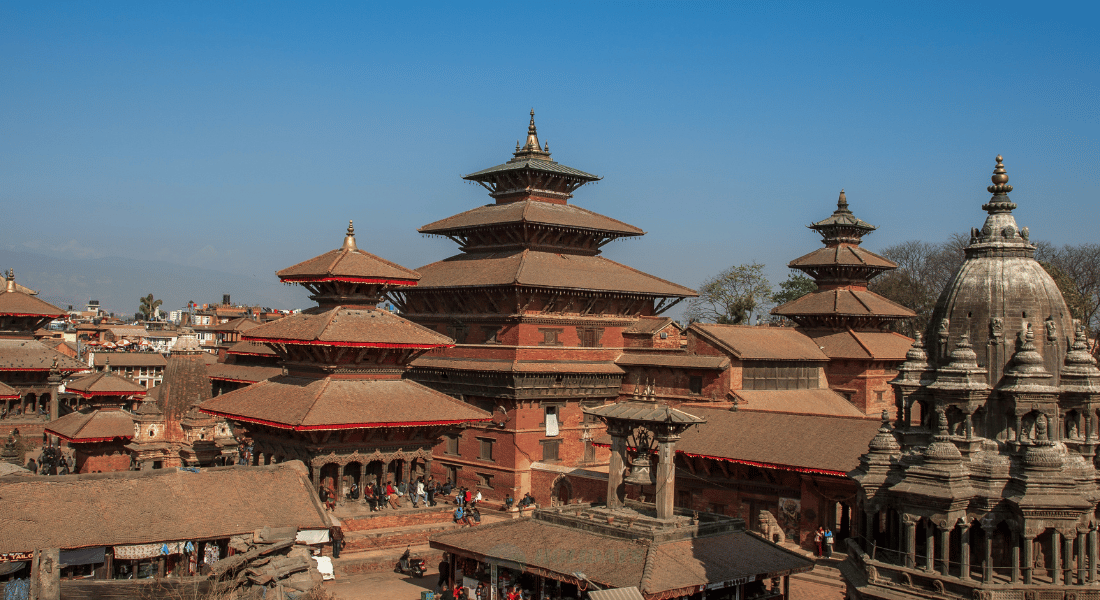
Among the most revered pilgrimage sites in Patan is the Krishna Mandir, a unique temple dedicated to Lord Krishna, built in the 17th century by King Siddhi Narasimha Malla. It is widely regarded for its architectural beauty, constructed entirely out of stone with intricate carvings depicting scenes from the Mahabharata and Ramayana. Another significant site is the Kumbheshwor Temple, dedicated to Lord Shiva, which is one of the oldest temples in Nepal, dating back to the 14th century. This temple is closely associated with the festival of Janai Purnima, and its five-tiered pagoda structure is an important pilgrimage destination. Another most reknowned temple, Bagalamukhi temple, dedicated to goddess Bagalamukhi (Bhagwati) who is said to be the protector of Patan.
Patan is also known for its vibrant Hindu festivals, which draw crowds of pilgrims and devotees each year. One of the most important celebrations is Krishna Janmashtami, marking the birth of Lord Krishna, during which Krishna Mandir becomes the focal point for worshippers. Another key festival is Rato Machindranath Jatra, a chariot procession that honours the rain god, Machindranath. While Rato Machindranath is a deity revered by both Hindus and Buddhists, the festival has deep Hindu significance and attracts pilgrims who seek blessings for prosperity and good harvests. During these festivals, Patan transforms into a hub of religious activity, showcasing its enduring significance as a Hindu pilgrimage site.
Patan Area Facts
Here are some facts related to Patan Area:
|
Site |
Patan/Lalitpur |
|
Major Attraction |
|
|
Major Festivals |
|
|
Entry Fee (Durbar Square) |
Foreigners - NRP 1000 SAARC Citizens - NRP 250 |
How to Reach?
To reach Patan from Kathmandu city centre such as Thamel or Durbar Marg, the journey is quick and convenient. You can take a taxi, which takes about 15-20 minutes depending on traffic, crossing the Bagmati River via the Pulchowk or Lagankhel roads. Public transportation options like buses and microbuses are also available, departing frequently from areas like Ratna Park and heading towards Patan's core areas such as Mangal Bazaar and Patan Durbar Square. Alternatively, for those who enjoy walking, it’s about a 30-45 minute walk from Kathmandu’s centre to Patan, depending on your pace.
Manakamana Temple
Manakamana Temple, 125 km outside Kathmandu Valley, is located in the Gorkha district at the top of a hill and is a highly revered Hindu pilgrimage site in Nepal. It is dedicated to Goddess Durga Bhagwati. The name Manakamana is made up of two words: "Mana,” meaning heart, and "Kamana,” meaning wishes. Therefore, the goddess is known as the goddess who grants wishes from the true heart. The location of the temple and the journey are equally enjoyable, adding to the scaredness of the temple.
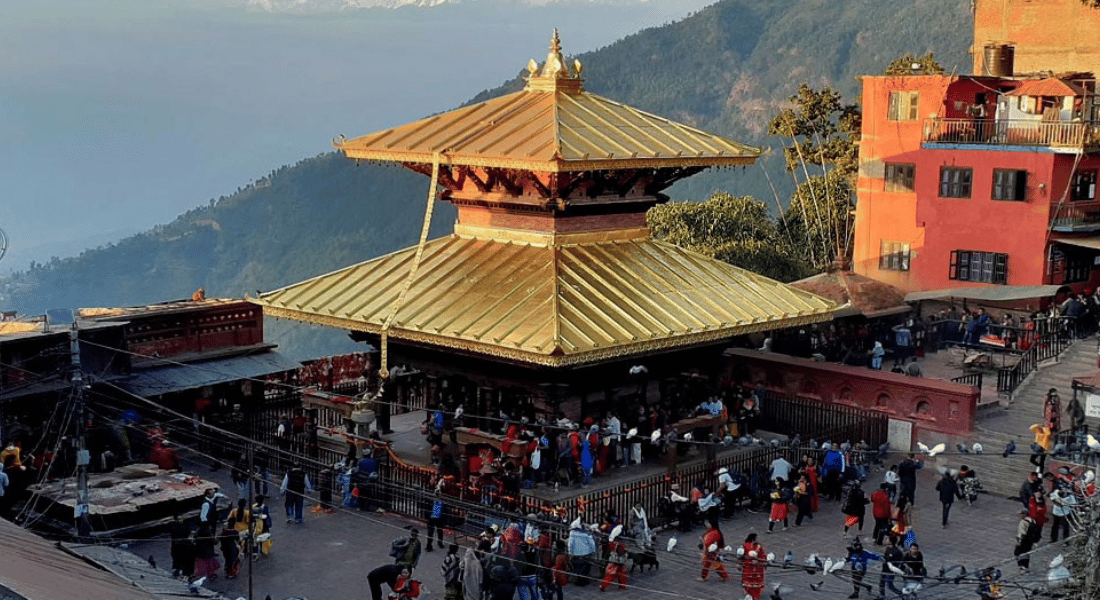
The Manakamana temple can be reached via a ropeway from the cable car base station. The temple is a 2 story structure made in traditional pagoda style architecture with golden roofs held by intricately decorated wooden struts. The goddess is situated at the centre of the sacrosanctum. The architecture of the temple is further enhanced by the surrounding environment. The air filled with the smell of burning incense and devotees offering their prayers to the goddess makes it a serene environment.
Pilgrims from all over Nepal and nearby countries, especially from India, come to this temple to get blessings from goddess Manakamana and get their wishes fulfilled. Major festivals and celebrations make up the temple's vibrant atmosphere, attracting pilgrims and tourists from all over the country and beyond. The major festival celebrated in this temple is Dashain, a major Hindu festival in Nepal in honour of goddess Durga. During this time of the year, the temple observes an influx of devotees performing rituals and making offerings. Another important event is the Maghe Sankranti, marking the winter solstice and celebrated with fervor. During these festivals, the temple grounds are decorated with colourful elements like flowers, and various traditional ceremonies and feasts take place.
Manakamana Temple Facts
Here are some facts related to Manakamana Temple:
|
Site |
Manakamana Temple |
|
Location |
Gorkha |
|
Affiliation |
Hinduism |
|
Deity |
Manakamana Mata (Bhagwati) |
|
Architecture Style |
Pagoda Style |
|
Major Attraction |
|
|
Major Festivals |
|
|
Opening Hours |
05:00 AM – 07:00 PM |
|
Cable Car Fee (Two Way) |
Nepalese Adults - NRP 770 Indian Adults - INR 670 Foreigner Adults - USD 20 |
How to Reach?
To reach Manakamana Temple from Kathmandu, start by driving to the town of Kurintar, which is about 105 kilometres west of Kathmandu. The journey typically takes around 3 to 4 hours by car, depending on traffic and road conditions. From Kurintar, you can take the Manakamana Cable Car, a scenic ride that offers stunning views of the surrounding landscape. The cable car journey itself takes about 10 minutes and takes you directly to the temple complex perched on a hilltop. Alternatively, if you prefer a more adventurous route, you can take a local bus or hire a private vehicle to reach Kurintar and then proceed with the cable car to the temple.
Learn More: Manakamana Temple
Bindyabasini Temple
Bindhyabasini Temple, dedicated to goddess Bindhyabasini (Bhagwati), is the oldest temple in the city of Pokhara. Goddess Bindhyabasini is believed to be the guardian deity of Pokhara. Located on top of a hill, the Bindhyabasini temple is believed to be overseeing all the activities of Pokhara and protecting its residence from evil. The setting of the temple makes the appearance of the temple even more attractive. The visual attraction of the surrounding mountain peaks is like the fishtail, Annapurna, and Dhawalagriri in distance.
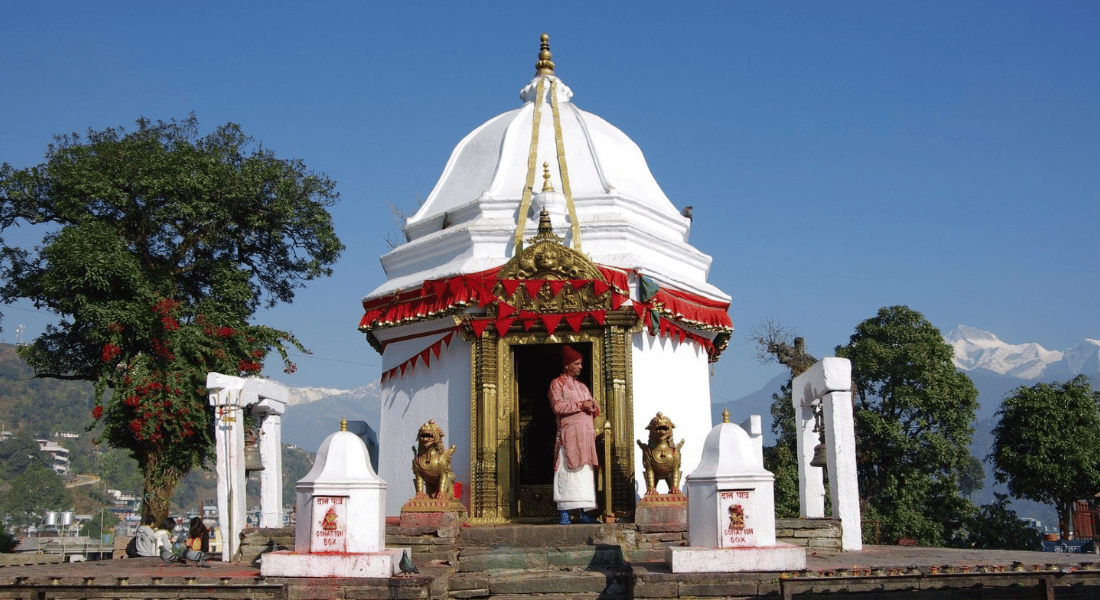
The Bindhyabasini temple is said to have been established in the 17th century by King Siddgi Narayana Shash. The temple’s architecture is made in traditional Shikhara style, which is painted white. In front of the golden metal gate of the temple are two golden metal lions, which are placed there as it is the sacred ride of goddess Durga. An idol of Goddess Bidhyabasini in her ferocious form with multiple arms is placed inside the small temple, which is surrounded by a multiheaded silver serpent. The goddess is usually adorned with silver ornaments like crowns and necklaces. There are several other temples dedicated to different gods and goddesses around the temple complex, including temples of Lord Shiva, Hanuman, Ganesha, Ram Sita, Radha Krishna, and many others.
Bindhyabasini is one of the must visit temples in Pokhara and has been a source of reverence for the locals as well as pilgrims for ages. Doevotes come to offer prayers and seek the blessing and protection from the goddess regularly. Especially during festivals like Dashain and Tihar, the temple gets a huge number of visitors from all over the country and beyond. During these festivals, the temple's atmosphere gets lively with decoration and visitors engaging in various religious activities like singing and dancing in bhajans (religious music).
Bindhyabasini Temple Facts
Here are some facts related to Bindhyabasini Temple:
|
Site |
Bindhyabasini Temple |
|
Location |
Pokhara |
|
Affiliation |
Hinduism |
|
Deity |
Bindhyabasini Mata (Bhagwati) |
|
Architecture Style |
Shikhara Style |
|
Major Attraction |
|
|
Major Festivals |
|
|
Opening Hours |
05:00 AM – 7:00 PM |
|
Entry Fee |
No Entry Fee |
How to Reach?
To reach Bindhyabasini Temple from Lakeside in Pokhara, you can start by heading east from Lakeside, following the main road towards the Old Bazaar area. The journey is approximately 2 kilometres and takes about 10 to 15 minutes by taxi or rickshaw. Alternatively, you can take a leisurely walk through the bustling streets and local markets, which offers a chance to experience the vibrant life of Pokhara. Once you reach the Old Bazaar, follow the signs and local directions up a hill to the temple, which sits atop a small rise offering panoramic views of the city and the surrounding mountains.
Learn More: Bindyabasini Temple
Halesi Mahadev Temple
Halesi Mahadev Temple is a popular Hindu, Buddhist, and Kirati pilgrimage site located in the district of Khotang in Eastern Nepal. This ancient cave temple is also known as the Pashupatinath Temple of the East. While Hindus believe that it is the place where Lord Shiva sought refuge while hiding from a demon named Bhasmasur, Buddhists believe that it is where Guru Rinpoche meditated and gained immortality, and Kiratis believe that it is where Raechhakule, their ancestral deity, resided. Besides the religious purpose, Halesi could attract the visitor’s eye with its natural beauty, surroundings, and landscape views.
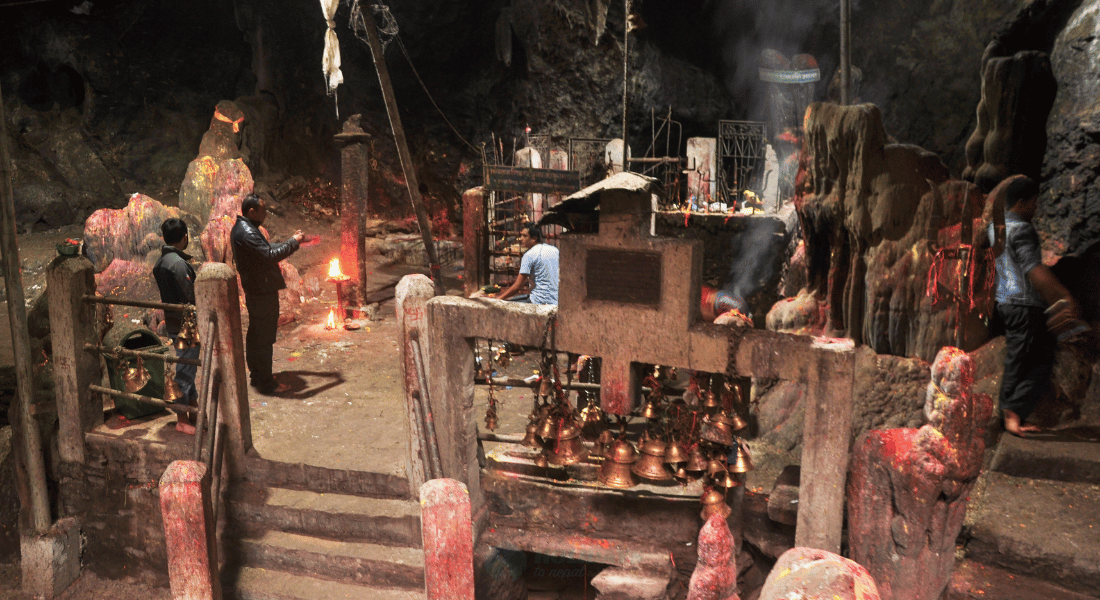
The Halesi Mahadev temple is a cave temple dedicated to Lord Shiva. The temple is inside the cave (67 feet below), which lies in between the Dudh Koshi and Sun Koshi rivers. Before entering the Halesi Mahadev Cave, there are several other religious monuments at the top, like monasteries and temples. To visit the temple, one has to go down some stairs to reach the sacrosanctum, where the main shrine, the shivalinga with Lord Shiva’s face in 4 directions, is located. Besides the sacrosanctum also consist 5 dwaras, namely swarga, dharma, paap, janma, and karma dwara, which is basically 5 small passages on a huge rock. It is believed that if one can pass through all the dwaras, then they can achieve ultimate enlightenment.
The Halesi Mahadev Temple observes several major festivals, attracting pilgrims and devotees from within and outside the country. During festivals like Shivaratri, Teej, Bala Chaturdashi, Udhauli, and Ubhauli Parva, this temple receives a huge number of visitors. These festivals play a significant role in conserving the centuries old traditions and bringing alive the charm of the temple with devotion and prayer.
Halesi Mahadev Temple Facts
Here are some facts related to Halesi Mahadev Temple:
|
Site |
Halesi Mahadev |
|
Location |
Halesi, Khotang |
|
Affiliation |
|
|
Deity |
|
|
Architecture Style |
Natural Cave Temple |
|
Major Attraction |
|
|
Major Festivals |
|
|
Opening Hours |
06:00 AM – 08:00 PM |
|
Entry Fee |
No Entry Fee |
How to Reach?
To reach Halesi Mahadev Temple from Kathmandu, you have several options. For a direct route, hiring a private vehicle is ideal, taking approximately 8 to 9 hours to cover the 220 kilometres through scenic yet rugged terrain. Alternatively, budget travellers can opt for a public bus to Khotang, followed by local transport or a hike to the temple. For a quicker journey, consider flying: charter a helicopter for a two-hour round trip. Air travel offers efficiency and stunning views but may be more expensive and subject to weather delays.
Learn More: Halesi Mahadev Temple
Pathibhara Devi Temple
Pathibhara Temple lies in the Taplejung District, in the eastern part of Nepal. The most powerful sakti peeth of eastern Nepal is dedicated to Goddess Pathibhara. The hill of Pathibhara has a shape like a pile of grains (pathi in Nepali), which is why the goddess is called Pathibhara even though she is Goddess Durga. Located at an altitude of 3794 metres, Pathibhara’s spiritual atmosphere is heightened by the panoramic mountain view of tall mountains like Mt. Kumbhakarna, Mt. Kanchenjunga, and Mt. Makalu. It is believed that a pilgrimage to this temple ensures the fulfilment of the pilgrim’s wishes.
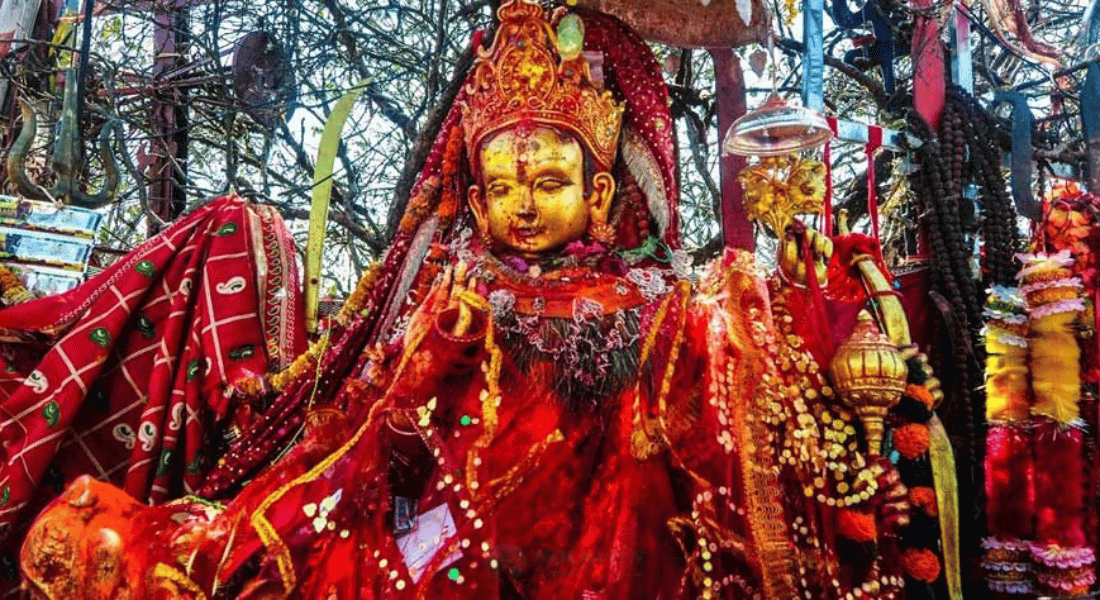
Right after the entrance gate of Pathibhara, on the right hand side, there is an idol of Lord Ganesha, who is worshipped first according to Hindu rituals. Then there is a place of worship for Lord Shiva, Bhairab, Kalika Devi, and many other deities. Finally, the temple complex consists of a small shrine housing the goddess's idol, which is adorned with vibrant red and yellow cloths and is often surrounded by offerings of flowers, fruits, and candles. Pathibhara Devi is believed to fulfil the wishes of devotees, and the temple attracts a multitude of pilgrims seeking blessings for health, prosperity, and success.
Pathibhara Temple is not only a significant religious site but also an important cultural landmark for the local communities. The festival of Maghe Sankranti and Navaratri draws a large number of visitors and is marked by vibrant celebration and traditional rituals. During these festivals, devotees offer animal sacrifice, gold, and silver to the goddess in hope that their wishes will be fulfilled. The temple plays a central role in the cultural life of the region, reflecting the deep-rooted spiritual traditions and the enduring connection between the people and their natural environment.
Pathibhara Temple Facts
Here are some facts related to Pathibhara Temple:
|
Site |
Pathibhara Temple |
|
Location |
Taplejung |
|
Affiliation |
Hinduism |
|
Deity |
Pathibhara Devi (Durga) |
|
Architecture Style |
Open |
|
Major Attraction |
|
|
Major Festivals |
|
|
Opening Hours |
06:00 AM – 07:30 PM |
|
Entry Fee |
No Entry Fee |
How to reach?
To reach Pathibhara Temple from Kathmandu by road, start by taking a bus or private vehicle to Taplejung, which is about a 16 to 18-hour drive, depending on road conditions. From Taplejung, travel by local jeep or hike to Kaflepati (Tallo Phedi), which takes around an hour. From Kaflepati, trek to Thulo Phedi, a journey of about an hour that includes ascending stone stairs. The final leg of the trek from Thulo Phedi to Pathibhara Temple takes about 2 to 3 hours, depending on your pace. On this route, you'll pass a smaller Pathibhara Mata shrine. Facilities like toilets, resting spaces, and drinking water are available along the way.
Alternatively, for a quicker journey, you can fly from Kathmandu to Suketar Airport in Taplejung. From Suketar, take a local vehicle to Kaflepati (Tallo Phedi), then follow the same trekking route from Kaflepati to Thulo Phedi and onwards to Pathibhara Temple.
Note: The flight to Suketar from Kathmandu is scheduled once a week. If one can not wait for the flight, then another nearest airport is Bhadrapur airport, from where Kalflepati is around 224 km, which takes around 8 hours to reach.
Learn More: Pathibhara Temple of Nepal
Janakpurdham
Janakpurdham, or better known as Janakpur, is a famous Hindu pilgrimage site located in the south-east region of Nepal. This sacred place is also connected to the epic Ramayana, as it is the place where Goddess Sita, Lord Rama’s wife, was born. This ancient Mithila kingdom was where King Janak ruled during the time of Ramayan. and where the ancient Mithila kingdom of King Janaka was. It is also the place where Lord Rama took part in the sita swayamvar, won the hand of Sita Mata, and married her. With its historical temples, vibrant streets with mithila arts, and deep mythology, Janakpurdham is a must visit Hindu pilgrimage site in the world.
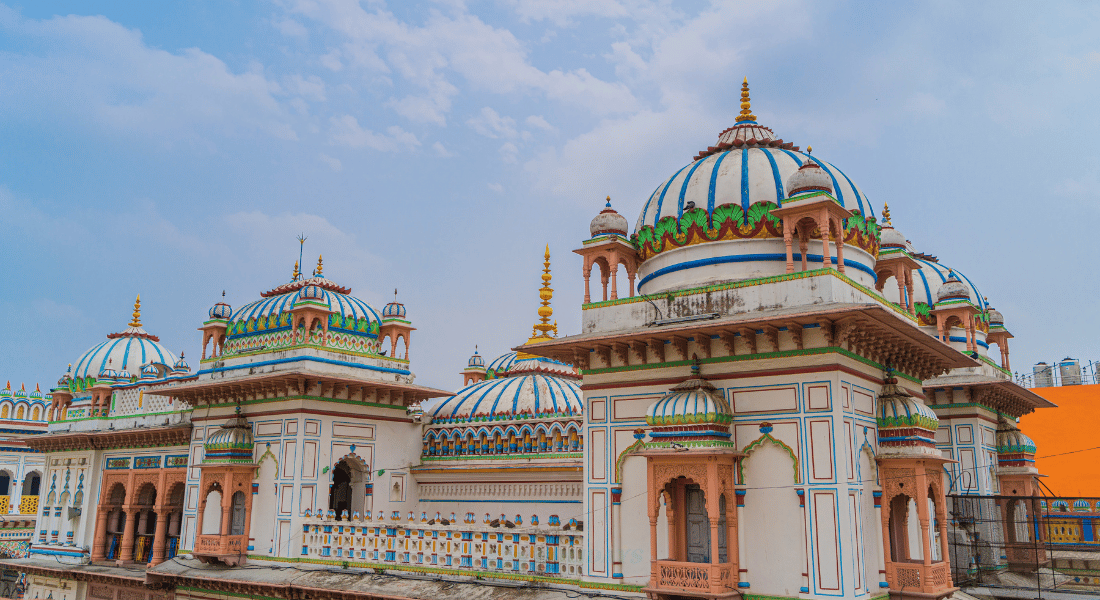
There are several important pilgrimage attractions scattered around Janakpurdham, among which the Janaki Mandir stands out as the most significant. This grand temple, dedicated to Goddess Sita, is a magnificent example of traditional Mithila architecture and is visited by devotees who come to offer prayers and seek blessings. Another important site is the Ram Mandir, which celebrated Lord Rama's connection to the region. Additionally, the area is dotted with various sacred ponds and shrines, such as the Ganga Sagar and the Vivah Mandap, which are integral to the spiritual experience of visitors. These sites not only attract pilgrims but also serve as important centres for religious activities and cultural gatherings.
Festivals in Janakpurdham are celebrated with immense enthusiasm and devotion, reflecting the vibrant religious life of the city. One of the most significant festivals is Vivah Panchami, which marks the marriage of Sita and Rama. This event is celebrated with grand processions, rituals, and cultural performances that draw thousands of visitors. Another major festival is Ram Navami, the birth anniversary of Lord Rama, which sees elaborate celebrations including recitations of the Ramayana and devotional music. Each of these festivals enriches the spiritual ambience of Janakpurdham and reinforces its status as a central hub of Hindu worship and tradition.
Janakpurdham Facts
Here are some facts related to Janakpurdham:
|
Site |
Janakpurdham |
|
Location |
Janakpur, Nepal |
|
Major Attraction |
|
|
Major Festivals |
|
How to reach?
To reach Janakpurdham from Kathmandu, you have several options. The most common and convenient way is by bus; you can take a tourist or local bus from the New Bus Park in Kathmandu, which typically takes around 8 to 10 hours. For a faster alternative, you can opt for a domestic flight, which usually takes about 30 minutes and lands at Janakpur Airport. Flights offer a quick and scenic route, but availability and schedules may vary. Additionally, private vehicles provide a more flexible travel option, allowing for a customised journey that can take approximately 6 to 8 hours, depending on traffic and road conditions.
Learn More: Janakpur Nepal
Muktinath Temple
Muktinath Temple, located in the Mustang district of Nepal, is one of the most sacred pilgrimage sites for Hindus and Buddhists alike. Situated at an altitude of 3,710 metres (12,172 feet) in the Himalayas, this revered shrine is dedicated to Lord Vishnu, who is worshipped here in the form of Muktinath, the deity of salvation. The temple's high-altitude location and remote setting add to its mystical allure, drawing devotees who seek spiritual solace and enlightenment. Its significance is further amplified by its association with both Hindu and Buddhist traditions, making it a unique and inclusive site of worship.
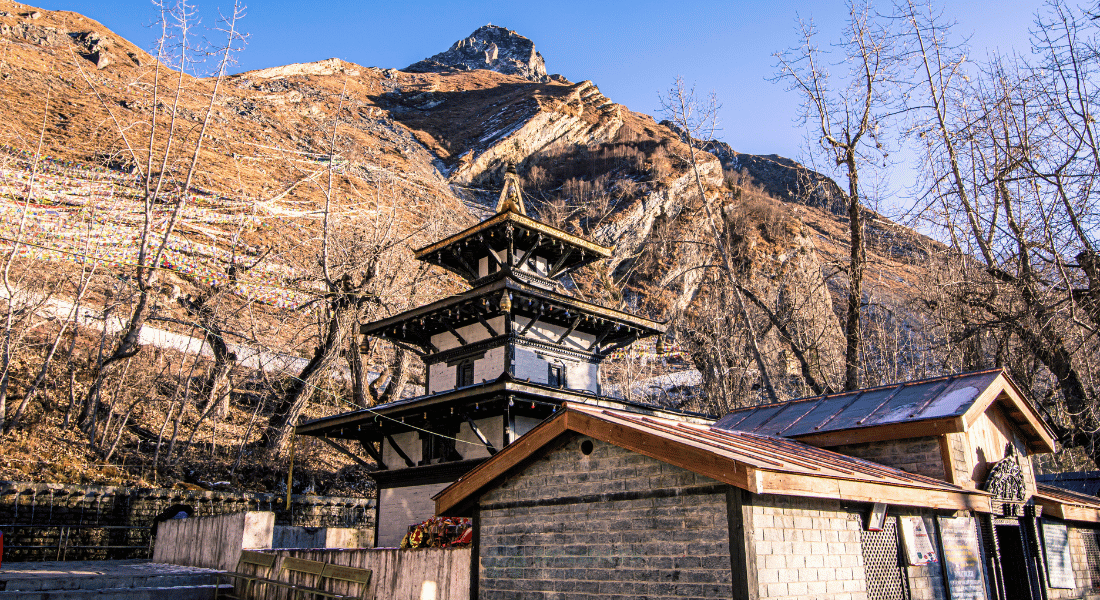
The Muktinath Temple complex is renowned for its distinctive religious features and sacred elements. The temple houses a brass idol of Lord Vishnu and is surrounded by 108 water spouts, known as the Muktidhara, which are believed to have purifying properties. Pilgrims perform ritual ablutions under these spouts, symbolising the cleansing of sins. The temple is also famous for its eternal flame, a natural gas fire that burns continuously at the base of a shrine, which is said to represent the divine presence. Additionally, the nearby Jwala Mai Temple, dedicated to the goddess of flames, and the Laxmi Narayan Temple enhance the site's spiritual significance, offering a comprehensive religious experience for visitors.
Festivals at Muktinath Temple are celebrated with great devotion and fervour, attracting thousands of pilgrims each year. The most prominent festival is the Muktinath Festival, held annually, which sees devotees from various regions come together to partake in rituals, prayers, and offerings. During this time, the temple is adorned with decorations, and special ceremonies are conducted to honour Lord Vishnu. The annual pilgrimage season, particularly in the months of September and October, is marked by vibrant gatherings and traditional celebrations that highlight the rich cultural and spiritual heritage of the Muktinath region.
Muktinath Temple Facts
Here are some facts related to Muktinath Temple:
|
Site |
Muktinath Temple |
|
Location |
Lower Mustang |
|
Affiliation |
|
|
Deity |
|
|
Architecture Style |
Pagoda Style |
|
Major Attraction |
|
|
Major Festivals |
|
|
Opening Hours |
06:00 AM – 08:30 PM |
|
Entry Fee |
No Entry Fee |
How to reach?
To reach Muktinath Temple from Jomsom, you can take a scenic and adventurous drive or hike through the rugged terrain of the Mustang region in Nepal. The journey typically involves a drive of about 2 to 4 hours, depending on road conditions and vehicle type. Alternatively, for those seeking a more immersive experience, a trek from Jomsom to Muktinath, which spans around 10 to 12 kilometres.
Learn More: Muktinath Temple
Devghat
Devghat is one of the most well known religious and cultural sites in Chitwan, Nepal. Located at the confluence of the Kali Gandaki and Krishna Gandaki rivers, it has been a highly revered Hindu pilgrimage site for ages. For Hindus, any confluence of the river is considered a holy site. This place has been mentioned in several Hindu Scriptures, such as the Baraha Puran, Skanda Purna, Padma Puran, and the Humavatkhanda.

Situated around 7 kilometres from the city of Narayangarh, Devghat is home to various temples and caves dedicated to different Hindu gods, goddesses, and saints. Devghat features a large number of shrines, temples, ashrams, and old age homes. The most prominent is the Chakreshwar Temple, where the famed King Mukunda Sen of Palpa is said to have meditated and attained Nirvana in the 16th century. Many elderly Hindu devouts stay here to spend their last days in the belief that breathing their last here will assure them a place in heaven. It is said that this holy place will cleanse all sinful deeds done in this life. During the Makar Sankranti festival, thousands of pilgrims visit this sacred site and take holy baths on the Kali Gandaki river.
Devghat Facts
Here are some facts related to Devghat:
|
Site |
Devghat |
|
Location |
Chitwan |
|
Affiliation |
Hinduism |
|
Major Attraction |
|
|
Major Festivals |
Maghe Sakranti |
|
Entry Fee |
No Entry Fee |
How to reach?
To reach Devghat from Chitwan, you can start by taking a bus or taxi from Chitwan to the town of Narayanghat, which is a major transportation hub. From Narayanghat, you will need to continue your journey towards Devghat by taking a local bus or hiring a private vehicle. The drive to Devghat typically takes around 1 to 2 hours, depending on traffic and road conditions.
Travel Tips for Pilgrims
Here are some tips that one might need for a religious Hindu pilgrimage in Nepal:
-
Plan Ahead: Research the key pilgrimage sites you wish to visit, such as Pashupatinath, Janakpur, or Muktinath. Understanding the cultural and religious significance of each site will enrich your experience.
-
Respect Local Customs: Dress modestly and follow local customs. Women should cover their shoulders and knees, and it’s respectful to remove shoes before entering temples.
-
Travel During the Right Season: Pilgrimage sites can be crowded during festivals and peak seasons. Travelling during off-peak times can offer a more serene experience. Be mindful of weather conditions and plan accordingly.
-
Stay Hydrated and Eat Wisely: Stick to bottled water and eat at reputable places to avoid stomach issues. Carry snacks and water, especially if you’re visiting remote locations.
-
Learn Basic Nepali Phrases: Knowing a few words and phrases can be helpful for communication and shows respect for the local culture. Simple greetings and thank-yous go a long way.
-
Use Local Guides: Hiring a local guide can enhance your experience, providing insights into religious practices and history that you might not find in guidebooks.
-
Keep Your Belongings Safe: Be cautious with your belongings, especially in crowded areas. Use a money belt or secure bag for valuables.
-
Follow Environmental Guidelines: Respect nature and local regulations, especially in sacred areas. Avoid littering and adhere to any guidelines provided by temple authorities.
-
Health Precautions: Make sure to get any required vaccinations and carry a basic medical kit. Be aware of altitude sickness if visiting high-altitude sites.
-
Embrace the Experience: Be open to learning and participating in rituals. The spiritual and cultural richness of the pilgrimage will be most rewarding when approached with respect and curiosity.
These tips should help you have a smooth and fulfilling pilgrimage experience in Nepal.
Conclusion
Nepal stands as a profound and sacred destination for Hindu pilgrims, offering a rich tapestry of spiritual experiences across its diverse landscapes. From the revered temples of Pashupatinath and Janaki Temple to the tranquil banks of the Kali Gandaki River at Muktinath, each site holds deep religious significance and provides a unique opportunity for personal reflection and devotion. The country’s blend of cultural heritage and natural beauty not only enhances the pilgrimage experience but also ensures a journey that resonates long after your visit.
Whether you are embarking on a spiritual quest or seeking to deepen your understanding of Hindu traditions, Nepal’s pilgrimage sites offer an unparalleled opportunity to connect with ancient practices and sacred history. Embracing the local customs, respecting the sanctity of each site, and engaging with the vibrant communities will enrich your pilgrimage and create lasting memories. As you traverse this spiritual landscape, you will find that the journey itself becomes a transformative experience, fostering both inner peace and a deeper appreciation for the profound spirituality that defines Nepal.
Related Package: Nepal Pilgrimage Tour Package
Frequently Asked Questions (FAQs)
Here are some frequently asked questions related to hindu pilgrimages sites in Nepal by visitors:
Why is Kathmandu called the city of temples?
Kathmandu is called the "City of Temples" due to its rich history of religious and cultural heritage, particularly its numerous Hindu and Buddhist temples. The city is home to many ancient temples, shrines, stupas, and pagodas, some dating back to the mediaeval period. Notable examples include the Pashupatinath Temple, Swayambhunath Stupa (Monkey Temple), and Boudhanath Stupa. These religious structures are integral to the city's landscape and attract worshippers and tourists alike, earning Kathmandu its nickname.
What are the major Hindu pilgrimage sites in Nepal?
Nepal has several important Hindu pilgrimage sites. The major ones include:
-
Pashupatinath Temple (Kathmandu): Dedicated to Lord Shiva, one of the holiest temples for Hindus.
-
Muktinath Temple (Mustang): A sacred place for both Hindus and Buddhists, dedicated to Lord Vishnu.
-
Janaki Mandir (Janakpur): Dedicated to Goddess Sita, the wife of Lord Rama, and located in the birthplace of Sita.
-
Manakamana Temple (Gorkha): Dedicated to the goddess Manakamana, believed to fulfill the wishes of her devotees.
Is Nepal a Hindu nation?
Nepal is not officially a Hindu nation anymore. It was declared a secular state in the 2007 interim constitution following the end of the monarchy. However, Hinduism remains the dominant religion, practiced by about 81% of the population, and Hindu traditions still influence many aspects of Nepalese culture, festivals, and daily life. Before becoming secular, Nepal was the only official Hindu kingdom in the world.
Are there any dress codes for entering the temples in Nepal?
There are not any regulations regarding the dress codes while entering temples in Nepal. But visitors are expected to dress modestly, with clothing that covers the shoulders, chest, and knees. Shoes must be removed before entering the inner sanctum of most temples.
Can I click pictures in these pilgrimage sites?
For photography, it depends on the specific site. Many temples, like Pashupatinath, prohibit photography inside the main shrine, but photos may be allowed in outer areas. It's always best to check the rules at each temple or ask local authorities before taking pictures.


